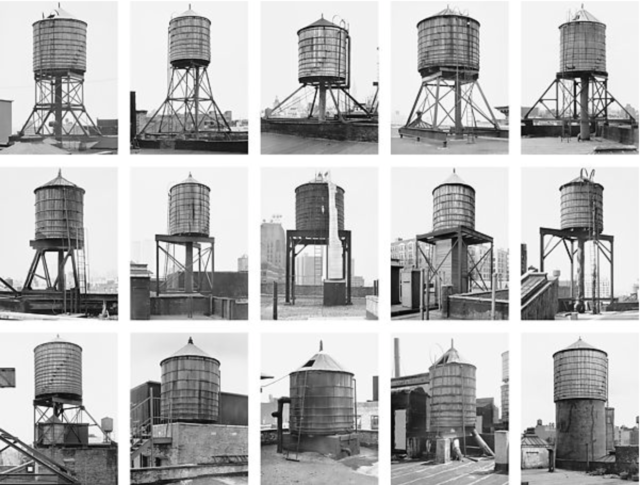
Bernd and Hilla Becher, Water Towers (New York, United States), gelatin silver prints, 1978–79 (Estate Bernd & Hilla Becher, represented by Max Becher, courtesy Die Photographische Sammlung/SK Stiftung Kultur — Bernd & Hilla Becher Archive, Cologne)
BERND & HILLA BECHER
The Met Fifth Avenue
1000 Fifth Ave. at 82nd St.
Through November 6, $17-$30
www.metmuseum.org
There are only a few days left to see one of the best exhibits of the year, the posthumous retrospective “Bernd and Hilla Becher,” continuing at the Met through November 6. Beginning in 1959, Bernd and Hilla Becher took photographs of chemical factories, water towers, gas tanks, grain silos, lime kilns, blast furnaces, framework houses, and more, using a large-format camera. They weren’t merely taking photos for posterity; each snap was a carefully considered work of art in itself.
“Over the course of five decades, they created a body of work that is remarkable for its rigorous documentation of thousands of industrial structures throughout Western Europe and North America,” Getty Museum photography curator Virginia Heckert writes in her catalog essay, “Bernd and Hilla Becher: A Lifelong Project of Uninflected Passion.” She continues, “Their legacy is defined equally by the archive of essential visual information that their photographs provide about this often anonymous architecture from the late nineteenth to the mid-twentieth century and by their use of typological groupings to illuminate the basic forms — and functions — of specific structural types.”
Bernd (1931–2007) and Hilla (1934–2015) also arranged their black-and-white photos in artistic themed grids, or “typologies,” that are as striking as the individual pictures; six images across two rows make up Industrial Facades (Germany and Belgium), while there are nine in Coal Tipples, Pennsylvania, United States, twelve in Details (Germany) and Grain Elevators (France and Germany), fifteen in Water Towers (New York, United States), twenty-four in Coal Bunkers (Germany, Belgium, United States, and France), and thirty in Blast Furnaces (United States, Germany, Luxembourg, France, and Belgium). There are also close-ups of leaves and metal forms and shots of mechanical equipment. The entire oeuvre recalls the 2004 Met exhibit “August Sander: People of the Twentieth Century — A Photographic Portrait of Germany,” in which the German artist sought to create an index of the German population.
Many of the individual photos, of what the Bechers called “anonymous sculpture,” are utterly gorgeous, imbued with an emotional power despite the subjects’ being inanimate objects; standouts include Water Tower, Verviers, Belgium; Cooling Tower, Zeche Mont Cenis, Herne, Ruhr Region, Germany; Chemical Factory, Wesseling / Cologne, Germany; Gravel Plant, Günzburg, Germany; and Framework House, Schloßblick 17, Kaan-Marienborn, Siegen, Germany. There are also sketches, collages, Polaroids, lithographs, and a few color photographs of the Bechers traveling in their VW bus; their only misstep is a short video in which they cut down a lovely tree in order to get a better angle on a building.
“They created a kind of factory of images, and they found a way to take something that’s enormous and photograph it so that we can see the poetics of each form,” exhibition curator Jeff Rosenheim says in the above virtual tour. “Bernd and Hilla Becher” unfolds across six well-themed, poetic galleries, but be prepared: The only people you’ll see are other visitors eager to catch this extraordinary show in its final days.